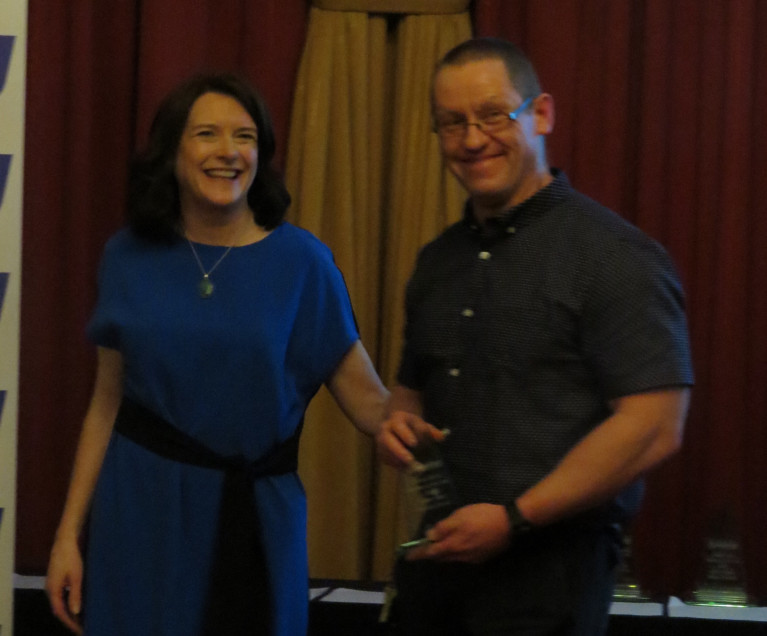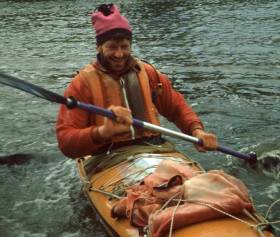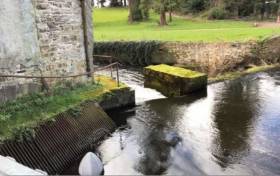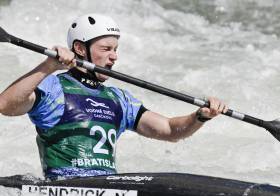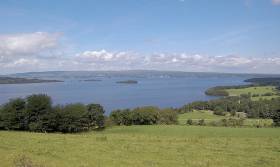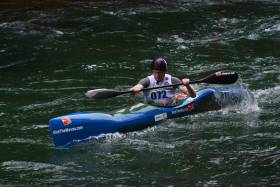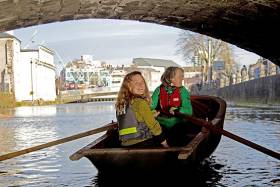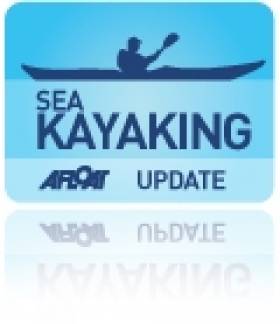Displaying items by tag: canoe
Canoe Awards Gala Honours Stars and Long-Time Mentor
The Canoeing Ireland Awards Gala on Saturday night, which marked achievements in the sport in 2019, had plenty to celebrate. Liam Jegou, who will represent Ireland in canoe slalom at the Tokyo Olympics and Robert Hendrick, who qualified the boat, were both honoured.
Paralympian Patrick O’Leary, who also qualfied for Tokyo, was presented with his award by Miriam Malone, the chief executive of Paralympics Ireland. Malone and Karen Coventry of Special Olympics Ireland were keynote speakers at the event in the Spa Hotel.
The roll of honour on the night was long: Jenny Egan was chosen as best senior female paddler of the year in both canoe marathon and canoe sprint; Peter Egan was the chosen senior male in marathon canoeing. The senior Freestyle winners were Aoife Hanrahan and David McClure; Aisling Griffin and Michael Barry took the honours in the Paddle Surf category; Ciara Gurhy and Oisin McKay took the Canoe Polo honours. In the Wild Water category Odhran McNally (kayak) and Darragh Clarke (canoe) were honoured.
Oisin Feery, who starred for Ireland at the Special Olympics World Games in Abu Dhabi, won the Special Achievement award; the Event of the Year was Meelick Riverfest; the Team of the Year, the Ireland under-21 women’s Canoe Polo team. The Community Impact prize went to McMahon Cup.
The Volunteer of the Year award went to a man behind many of the medals won by Ireland in Canoe Marathon and Canoe Sprint, the indefatigable Tom Egan.
Ireland by Kayak: Paddler Timmy Flavin's Log
“Stop for a quick apple and orange drink. Paddle on in flat water. Stop for cake and try throwing a lifebelt onto a beach...”
“ Arrive Courtown at about 11.15 to champagne and a congratulations cake reception! A lifetime trip was over....”
Timmy Flavin’s understated diary entry on June 16th, 1991 was recorded after a 942-mile paddle around the coast of Ireland with his fellow kayaker Donal Dowd.
Enduring stinging armpits, swelling fists, cracked lips, missing Raybans, endless storms and unplanned capsizes, the pair set out from Courtown pier, Co Wexford on May 11th, 1991.
After paddling through phosphorescent waters to the Saltee islands, they spent their first night with an orphaned chick in a nestbox provided by the Irish Wildbird Conservancy – as Birdwatch Ireland was then.
The pair paddled an average of just over 31 miles a day until they reached Courtown again four weeks later. The log kept by Flavin - in his best broad Cork accent- has now been published as an illustrated book by his wife Bríd Farrell as a tribute to her late husband’s epic adventure.
Flavin records both indispensable details for the kayaker contemplating a similar circumnavigation, and memories of people that he and Dowd met along the route. As Dowd says, “the ever-changing sea provided us with both tranquillity and white-knuckle fear..”
There are the peaks and troughs of an Atlantic swell, and there is also much humour. Leaving Ballywalter for Annalong, Co Down, on the final leg down the Irish Sea, Flavin reached for his Raybans, couldn’t find them, “and nearly collapsed with shock...” Somehow he survived squinting in the bright sunlight. By the time they pair reach Howth, north Dublin, their fragile hands could grip a paddle but could barely hold a litre of milk or orange juice.
The log includes an equipment list with useful comments on what was and wasn’t required. A silk scarf was “invaluable and essential, while a helmet “ was never used, not carried from Malin onwards”.
“Loose leaves” from a diary were “posted home regularly”, Flavin wrote, and “postage-paid cards were used”, but there was no reading material packed – “no book, no space”. There is also advice on food in the “menu” section, where the nightcap was “white coffee, sugar, Ovaltine, biscuits..”
Timmy Flavin died four years ago of cancer, and the book includes moving tributes to him penned by Donal Dowd, Tony Noctor and by Michael O’Sullivan, a colleague in the ESB where Flavin worked.
“A gentle quiver of a breeze must have passed over the MagGillycuddy’s Reeks and across the Atlantic waters to the Sceiligs, Blaskets, Bull Rock and down the channel of the Blackwater on the 28th May 2015, when Timmy Flavin took his last breath on earth,” O’Sullivan writes, charting the career of a “giant of a man”, proficient at both kayaking and orienteering and a volunteer instructor at Cappanalea outdoor pursuits centre in Co Kerry.
It was at Cappanalea that his future wife, Bríd, met him. All profits from her late husband’s log are being shared between the Kerry University Hospital’s Palliative Care Unit, and the RNLI Valentia lifeboat station, in Co Kerry.
At the Water’s Edge: Two Boats – Around Ireland by Kayak by Timmy Flavin is priced €15 and copies are available directly from Bríd Farrell at email address: [email protected]
The State’s Marine Casualty Investigation Board (MCIB) has been unable to identify the precise circumstances which led to the death of an experienced canoeist on the river Suir in Cahir, Co Tipperary in November, 2017 writes Lorna Siggins.
However, next of kin and a witness to the incident have taken issue with several key aspects of the MCIB report, published on Wednesday.
The canoeist, who was a medal-winning slalom competitor, drowned after he capsized below a weir close to Cahir Castle while leading a group of paddlers.
The 185km-long river Suir rises just north of Templemore, Co Tipperary passes through Cahir, Clonmel and Carrick on Suir, Co Waterford.
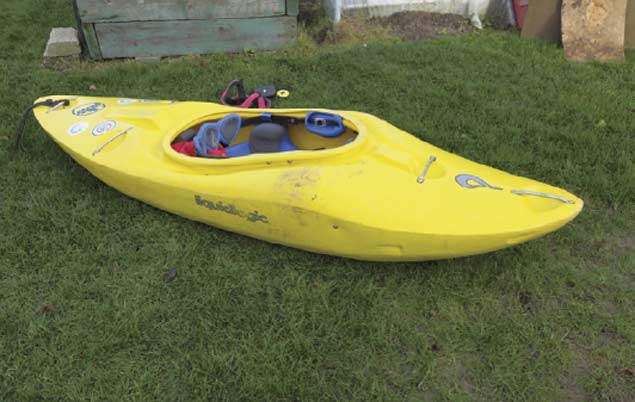 The canoe that capsized Photo: MCIB
The canoe that capsized Photo: MCIB
After he capsized, the canoeist was initially seen not to be in any difficulty but disappeared out of sight around a bend.
The MCIB report concludes that was unable to rescue himself and floated over 4 km downriver before he was recovered by emergency services.
The canoeist had been equipped with a buoyancy aid during the expedition, but was not wearing it when recovered from the water, and did not respond to first aid.
The incident occurred after a group of 12 kayakers, varying in age from nine years to 67 years and of different skill qualifications, left the town mall slip in Cahir at about 10.30 am on November 11th, 2017.
“Some of the group had their own kayaks and safety equipment and others had kayaks and safety equipment provided by the adventure organisation set up by the casualty and a partner,” the report states.
The group split in two, and one group of four planned to navigate a weir on the western side of the Suir’s main channel, and then join the others.
“As the group of four approached the weir the casualty, the most experienced member of the group, gave verbal instructions as to how best to navigate the weir. He stated he would go first and be followed by the two teenagers and the man following last,” the report states.
The canoeist, described by the MCIB as a level 2 trainee kayak instructor, capsized and surfaced on the right-hand side of the river.
“ He was seen standing facing against the wall on the western downriver side of the weir and making his way downstream,” the report states.
“ He did not appear to be in any difficulty. He did not acknowledge or communicate in any way with the three remaining kayakers. He quickly went out of sight of remaining kayakers due to a bend in the tributary,”it states.
“The person was unable to rescue himself and get to safety and floated approximately 4.18 km down the River Suir where rescue services recovered him from the water. He did not respond to first aid,” it says.
The canoeist had been wearing his buoyancy aid prior to shooting the weir, and the MCIB concludes it was either “removed by the casualty or lost between the time of the incident and the time of the recovery”.
It notes that the buoyancy aids “ may be suitable in instances where the wearers remain capable of helping themselves” but “ should not be used in rough conditions or when there is wave splash”.
The report does note that this is “the standard buoyancy aid used for kayaking in Ireland”.
The canoeist was spotted at 11.30am by a passerby, and the Irish Coast Guard Waterford-based helicopter was tasked at 11.33am and Garda at Cahir was informed.
However, due to poor visibility, the helicopter had to request permission to stand down at 12.31
A local fire brigade unit tried to reach the casualty without success, and he was recovered at 12.38 from a location near Garnavilla House with the help of Suir River Rescue.
Next of kin of the canoeist, along with a witness, have taken issue with several aspects of the MCIB report, as outlined in correspondence published with the document.
The report states that there was “no documented record of a risk analysis of the potential dangers prior to setting out on the course over the weir” as per the code of practice for the safe operation of recreational craft.
The MCIB report also concludes that the canoeist’s adventure organisation was not affiliated to Canoeing Ireland – which, it acknowledges, is not a legal requirement.
Canoeing Ireland oversees training and qualification standards for the sport. Canoeing Clubs are affiliated to and regulated by the Irish Canoe Union.
“This is misleading as the members of the organisation were members of Canoe Ireland and were trained through Canoeing Ireland,” next of kin correspondence, which is included in the report’s appendices, states.
“ The members of the adventure club abided by the rules of Canoeing Ireland, so it is misleading and hinting that the association was less than official. They had applied for membership and were waiting for reply,” the correspondence says.
A witness also attests to the canoeist’s experience and to his membership of Canoeing Ireland and notes that the canoeist and other members of the club ran the sluice weir regularly and were very familiar with it in a variety of conditions.
In relation to a documented risk analysis, the next of kin correspondence also states that “the course had been studied for hidden dangers, snags, currents, etc before the boat was put on the water” and there was “also a plan of action on who would go in which order and how to go down”.
“ I do wonder where it says this risk analysis needs to be documented in writing and how many different passages and waterways are risk assessed in this way if it actually is required,”the next of kin correspondence says.
“This passage and river were well travelled by this group and this group was quite experienced. The risks had been assessed previously,”it says, and observes the MCIB seems to be “picking on a documentation issue”.
The next of kin correspondence says that the report “draws a strange and problematic conclusion”.
“I honestly cannot identify anything from this report that is useful or sheds some light on the situation or what would have helped avoid the situation,” the correspondence states.
The MCIB report, which did include amendments, “notes” the points raised in the correspondence.
It recommends that the Minister for Transport, Tourism and Sport issue a marine notice reminding kayakers, kayaking and canoeing organisations of obligations to comply with the code of practice for safe operation recreational craft and the relevant chapter dealing with canoeing/kayaking.
The full report can be downloaded here
McClure and Hendrick Best of Irish in Spain and Slovakia
#Canoeing: David McClure finished fifth in the final of the K1 Surface event at the canoe freestyle World Championships in Sort in Spain. At the canoe slalom European Under-23 Championships, Noel Hendrick reached the semi-finals and finished 26th in Liptovsky Mikulas in Slovakia. The Irishman had touches on gates three and 17, incurring four seconds in penalties.
CH Marine Buys Bantry Bay Canoes
Leading Irish Marine Firm CH Marine has taken over the interests of Bantry Bay Canoes, one of Ireland’s largest and best known canoe and kayak suppliers.
This Bandon-based company was previously owned by the major UK canoe and kayak chain - Canoe Shops Group. Although Bantry Bay Canoes now joins the CH Marine Group of companies, it is the intention of the new owners to keep it as a separate trading entity while employing combined buying power to bring better value to the market.
“We are delighted to have acquired Bantry Bay Canoes” says Nicholas Bendon, CEO of CH Marine. “They hold significant experience and expertise in the kayak world and we are very happy to have retained the expert services of Ciaran, the general manager. We look forward to supporting Ciaran as he continues to advance the company with more great ranges, exciting new products and, of course, the expertise and customer service that Bantry Bay Canoes is known for.”
Bantry Bay Canoes offers one of the most comprehensive ranges of kayaks and equipment available in the country, covering all disciplines. The vast range includes leisure sit-ons, touring, sea kayaking, fishing, whitewater, funboats and rescue kayaks. Bantry Bay Canoes sells top brands such as Perception, Hobie, Feelfree, Ocean, Wavesport, Dagger, Werner, Palm & Yak and many more quality names.
For more information contact Ciaran on 023-8829771 or at [email protected]
Lough Derg Canoe Trail To Be Completed By Early 2017
Canoe facilities and services blocks are being provided at various locations around Lough Derg as part of a new inland waters initiative aimed at promoting water-based activities on Ireland’s third largest lake.
Clare County Council has confirmed that the proposed Lough Derg Canoe Trail, which is scheduled for completion by January 2017, will see facilities installed in Killaloe, Ballycuggeran, and Scarriff, Mountshannon and Dromaan harbours.
The Trail project is an initiative of the Lough Derg Marketing Group and is being funded under the Lough Derg Stimulus Fund. Waterways Ireland is leading the design and development of the project in partnership with the Clare County Council, Galway County Council and Tipperary County Council.
Trail information signage is being provided at Canal Bank, Killaloe, where upgrade works to the existing slipway are also being undertaken. Works underway at the Mill Yard, Killaloe include the provision of trail information signage, a canoe storage rack and planting/screening of same. The works to Scarriff harbour include trail information signage, a canoe storage rack and screening and the installation of a new floating landing/launching step.
The works at Ballycuggeran include the provision of trail information signage, a canoe storage rack and screening, while Mountshannon will benefit from trail information signage, a canoe storage rack, and screening and the refurbishment of the existing service block. Dromaan harbour will see the provision of trail information signage, a canoe storage rack and screening and the construction of a new 3-unit service block and holding tank.
McNally Impresses at Wildwater World Championships
#Canoeing: Odhrán McNally finished eighth in the K1 men's sprint final at the ICF Wildwater World Championships on the Vrbas river, Banja Luka, Bosnia. The 19 year old was competing in his first senior wildwater Competition. He placed 17th out of 71 boats in the Classic race.
The heats for the Sprint final were hotly contested by world ranking paddlers. McNally placed 7th and 10th respectively winning him a place in the individual sprint final night race. McNally's time in the final, 54.98 seconds, was just 2.35 seconds off the race leader and 2016 WWR World Champion Maxime Richard of Belgium.
McNally now moves on to Celje in Slovenia for to race at the ICF Wildwater Canoeing World Cup Series which takes place June 9th to 11th.
A unique new tidal guide assisting river users to circumnavigate the city’s waterways was launched yesterday at the River Lee Hotel. CORKUMNAVIGATION is a pocket-sized map published by Cork’s community boatyard, Meitheal Mara. The guide is aimed at helping locals and visitors alike discover the city from a new angle by kayak, canoe or rowing boat. See link below to purchase the guide.
According to Cathy Buchanan of Meitheal Mara, ''very few people know that you can actually row or paddle all around the city, and experience a very different and special side of Cork. As several of the bridges are particularly low and some weirs quite high, they can only be passed at certain tides. With the CORKUMNAVIGATION guide you can successfully navigate the city’s 29 bridges and eight weirs at various stages of the tide.''
Niamh Twomey, Cork City Council Heritage Officer, added ''The River Lee is one of the great unexploited spaces in Cork, offering a beautiful route around the historic city centre. This guide will give the growing number of river users the opportunity to experience the natural and built heritage of Cork from the River Lee. The guide also includes quirky historical facts contributed by the late Cían Ó Sé.''
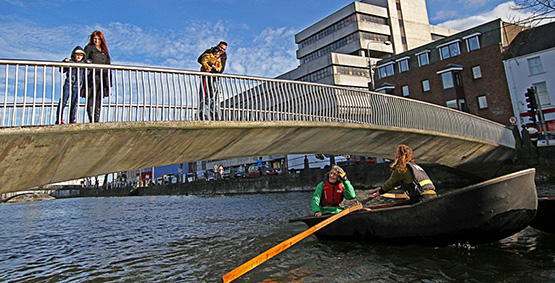
Corkumnavigate Cork city's 29 bridges and eight weirs with this latest pocket guide.
Originating near Gougane Barra in the Shehy Mountains, the River Lee flows east towards Cork City where it splits into two channels, forming the city's central island. Medieval Cork was a network of small river channels, which over the centuries have been covered in to leave just the north and south channels open. The river derives its name from the Irish "Laoi", meaning torrent or flood.
CORKUMNAVIGATION is a Meitheal Mara project, sponsored by Cork City Council and the River Lee Hotel. Fieldwork for the project was conducted in 2010 by the Cork Centre for Architectural Education, UCC and CIT, and sponsored by the Heritage Council.
The CORKUMNAVIGATION guide is available from Meitheal Mara via Afloat's Marine Market. Click HERE.
Jenny Egan Fourth at Canoe Marathon World Championships
#Canoeing: Jenny Egan finished fourth in the senior K1 event at the Canoe Marathon World Championships in Gyor in Hungary. Anna Koziskova of the Czech Republic took gold, covering the 26.1 kilometre course in one hour 56 minutes 28.847 seconds, while Egan was three minutes and just under 50 seconds further back. Egan was 57 seconds behind bronze medallist Kristina Bedec of Serbia.
Canoe Marathon World Championships, Gyor, Hungary
Men
K1 Senior, 30km: 25 P Egan 2 hrs 15 min 24.477sec ; B Watkins dnf. K1 Under-23, 26.1km: 18 T Brennan 1:56.378.177
Women
K1 Senior, 26.1km: 4 J Egan 2:00.18.166.
26 Canoeists Rescued From River Foyle
#foylerescue – A group of canoeiests are safe after capsizing on the river Foyle this afternoon and sparking a major resuce operation. At 2.05pm Belfast Coastguard was alerted by Police Service Northern Ireland, (PSNI) to an incident in the River Foyle involving two large capsized canoes with 26 people in the water.
Coleraine Coastguard Rescue Team was sent to the area and the Coastguard requested lifeboats from Foyle Search & Rescue, the Irish Coastguard rescue helicopter and Irish Coastguard boat from Greencastle. Northern Ireland Fire & Rescue Service also joined the search and rescue operation.
Lifeboats recovered 26 adults from the water and 12 people were transferred to hospital by helicopter and also by Northern Ireland Ambulance Service to be checked for hypothermia.
The group of 26 adults had got into difficulty after their two large canoes capsized.
The canoeists were taking part in a fundraiser for the YMCA. All 26 are now at Altnagelvin hospital with mild hypothermia, it has been reported.
The Coastguard recommends:
Safety Advice for Sea canoeing / kayaking: Ensure that someone at home knows your passage plan including points of arrival and departure, timescale, number in group and other relevant information. Check weather forecasts and tidal conditions and ensure that your skill levels are appropriate for where you are kayaking. Wear a buoyancy aid and check that equipment is functioning properly, that your distress flares are in date and are stowed where you can reach them. Carriage of a 406 Personal Locator Beacon is highly recommended for more remote locations.
Carry a VHF marine band radio (fitted with DSC if possible) and learn how to use it. Where there is good network coverage then it is worth carrying a mobile phone in a waterproof bag. Call the Coastguard if you get into difficulty, preferably via channel 16 on your radio or if not by calling 999 and asking for the Coastguard.


























